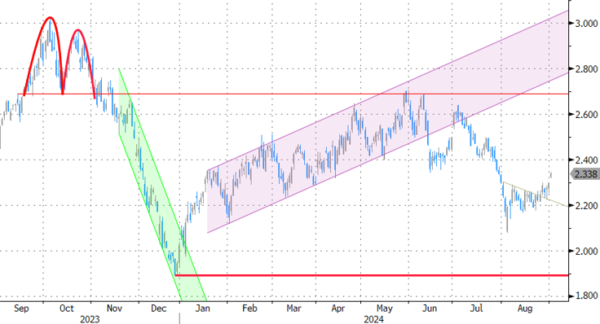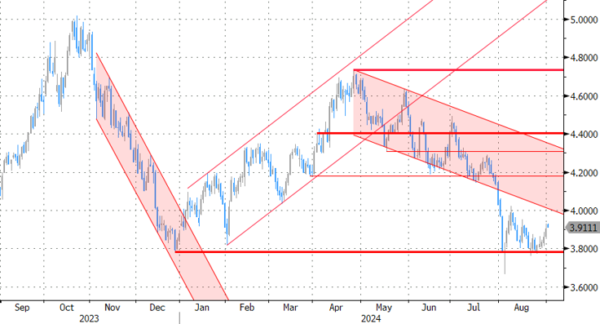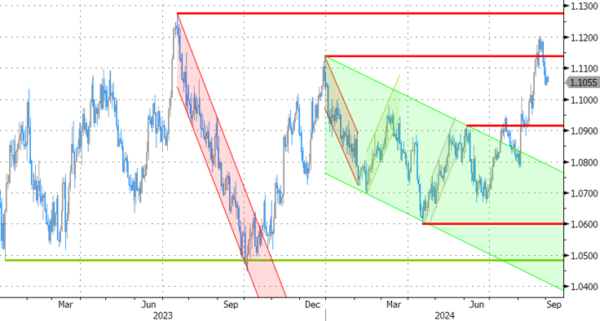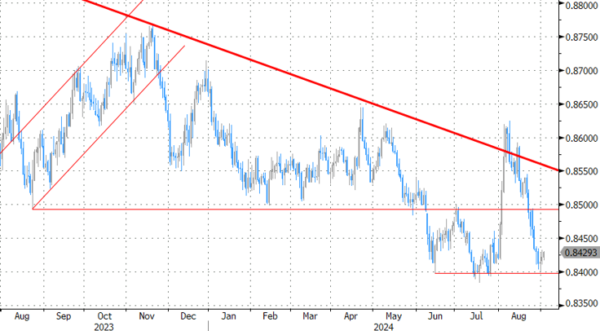Markets
European stocks opened in red, ended in green. German yields added some 3-4 bps, launching the 10-yr yield to the highest level since the August meltdown. And the Japanese yen lagged global peers on currency markets. That’s about all there is to say about yesterday’s uneventful, US-missing trading day. Morning news today remains very limited though we do pick up on an article ran by Bloomberg. The financial news agency, citing people familiar with the matter, said that ECB rate cuts beyond 3% will be a lot more contentious. Rates at the current level of 3.75% are still restrictive, making the next two to three moves down a no-brainer given poor economic momentum. Views in the policy committee, however, increasingly differ on the price outlook and the neutral rate – a matter that Reuters also raised just yesterday. Estimates on the latter range between 2-3%, meaning that rates below 3% for some (hawks) risks halting or even reversing the ongoing disinflationary process. Euro area money markets expect the ECB to have cut rates to around 2% by 2026.
US bonds trade for the first time this week after having enjoyed a long weekend for Labor Day. They add around 1 bp across the curve in Asian dealings. Commodity currencies trade in the defensive with the likes of the Aussie dollar pressured by faltering iron ore prices (nearing the 2024 multiyear lows). JPY tops the leaderboard, snapping a four-day decline against the dollar. Bank of Japan governor Ueda reaffirmed – in a document submitted to a government panel – that more hikes are coming if the economy and inflation evolve in line with the central bank’s outlook. Today’s economic calendar serves as an appetizer. The US manufacturing ISM is expected to recover to 47.5 from last month’s unexpected and sharp decline to 46.8. Such would be the first improvement in four months. We think it’ll be relevant for intraday trading purposes only though with several other key data prints to be released later this week. The payrolls report on Friday more specifically will all but settle the debate on the size of the Fed’s inaugural cut on September 18. From a market point of view, we’re especially interested in case of an upward surprise in today’s and the other data outcomes now yields appear to have hit the bottom back in August. It could support core/US bond yields in their recovery away from these recent lows/technical support zones. First meaningful support (USD resistance) in EUR/USD is located around 1.098-1.10. 102.16/102.36 is the mirror image in DXY.
News & Views
Inflation in South Korea in August rose 2.0% from 2.6% in July, touching the target of level of the Bank of Korea and marking the slowest pace of yearly price growth since March 2021. Even so, the rise was partially due to favourable base effects. In a monthly perspective prices still rose 0.4% M/M, up from 0.3% in July. Core inflation excluding food and energy prices slowed to 2.1% from 2.2% in July. The Bank of Korea assessed that the data showed that inflation was stabilizing more quickly than in other major economies and sees prices holding a stable trend going forward. The inflation data are raising the chances for a 25 bps interest rate cut at the October meeting even as the BoK recently showed concerns on the financial stability risks of higher house prices and a high level of household debt. The Korean won, which profited from the broader USD decline in August, this morning eased modestly to USD/KRW 1341.5.
British Retail Consortium data this morning showed that UK retail sales still rose at a modest 1.0% Y/Y in August, even as recent eco data suggested a better performance of the UK economy in the second half of the year. On a same store basis, sales were 0.8% higher compared to the same period last year. However, the upswing probably was at least partially related due to better weather conditions last month. Three-months, year-over over year food sales accelerated to 2.9% from 2.6%, but non-food sales remained in negative territory 3M-Y/Y (-1.7%).
Graphs
GE 10y yield
The ECB cut policy rates by 25 bps in June. Stubborn inflation (core, services) warrants a cautious approach on follow-up moves. Markets nevertheless price in two to three more cuts for 2024 as disappointing US and unconvincing EMU activity data rolled in, dragging the long end of the curve down. Yields bottomed in the wake of the August market meltdown, preluding a technical correction higher.
US 10y yield
The Fed in its July meeting paved the way for a first cut in September. It turned attentive to risks to the both sides of its dual mandate as the economy is moving to a better in to balance. Markets juggle between 25 and a 50 bps lift-off. The pivot weakened the technical picture in US yields with another batch of weak eco data pushing the 10-yr sub 4%. Powell at Jackson Hole didn’t challenge markets’ positioning.
EUR/USD
EUR/USD moved above the 1.09 resistance area as the dollar lost interest rate support at stealth pace. US recession risks and bets on fast and large (50 bps) rate cuts trumped traditional safe haven flows into USD. EUR/USD 1.12 was tested but survived. A (technical) dollar comeback then kicked in.
EUR/GBP
The BoE delivered a hawkish cut in August. Policy restrictiveness will be further unwound gradually on a pace determined by a broad range of data. The strategy similar to the ECB’s balances out EUR/GBP in a monetary perspective. Recent better UK activity data and a cautious assessment of BoE’s Bailey at Jackson Hole are pushing EUR/GBP lower in the 0.84/0.086 range.
















